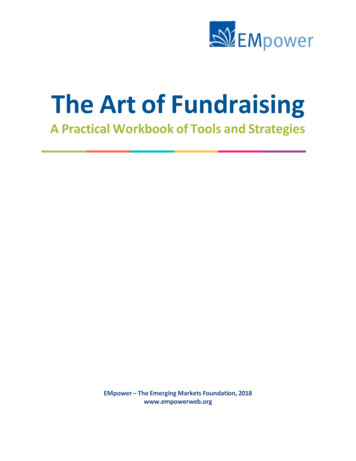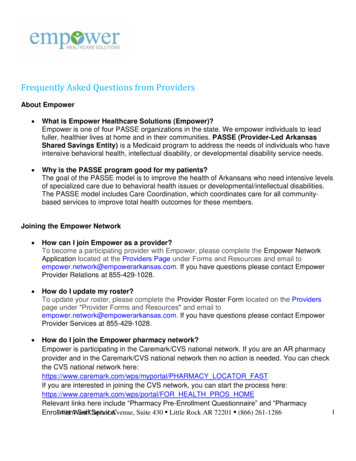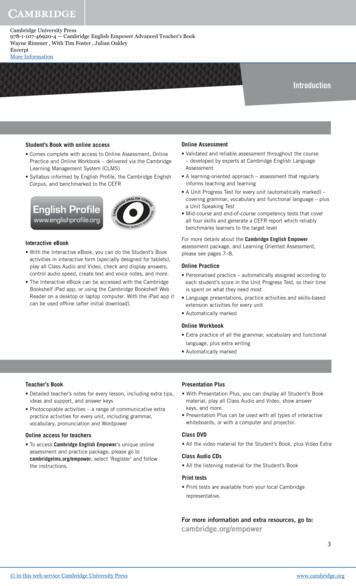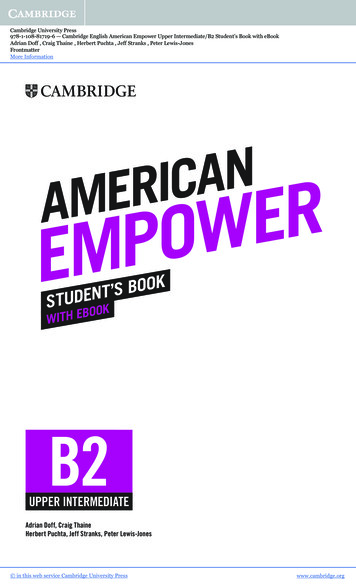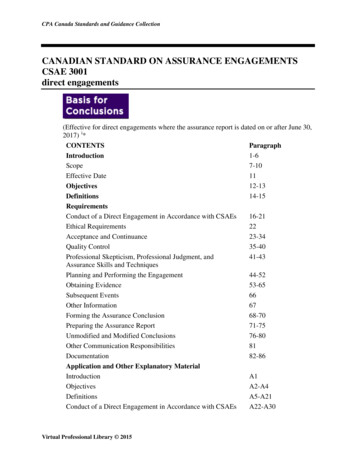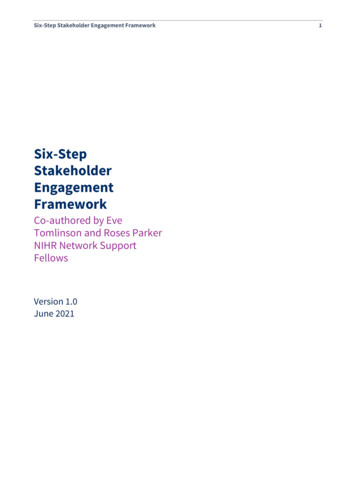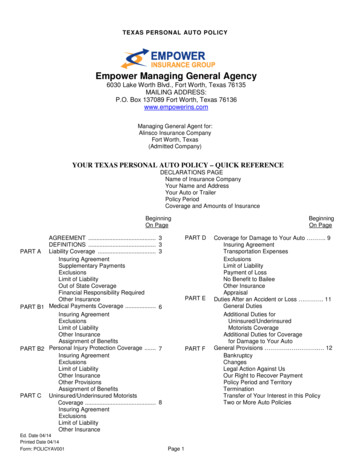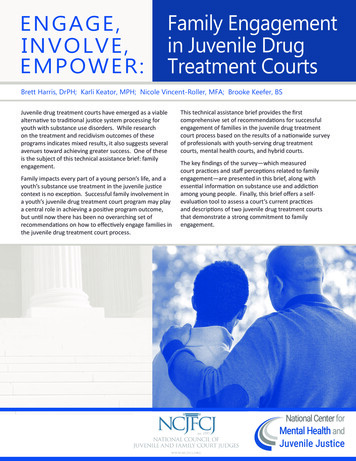
Transcription
ENGAGE,INVOLVE,EMPOWER:Family Engagementin Juvenile DrugTreatment CourtsBrett Harris, DrPH; Karli Keator, MPH; Nicole Vincent-Roller, MFA; Brooke Keefer, BSJuvenile drug treatment courts have emerged as a viablealternative to traditional justice system processing foryouth with substance use disorders. While researchon the treatment and recidivism outcomes of theseprograms indicates mixed results, it also suggests severalavenues toward achieving greater success. One of theseis the subject of this technical assistance brief: familyengagement.Family impacts every part of a young person’s life, and ayouth’s substance use treatment in the juvenile justicecontext is no exception. Successful family involvement ina youth’s juvenile drug treatment court program may playa central role in achieving a positive program outcome,but until now there has been no overarching set ofrecommendations on how to effectively engage families inthe juvenile drug treatment court process.This technical assistance brief provides the firstcomprehensive set of recommendations for successfulengagement of families in the juvenile drug treatmentcourt process based on the results of a nationwide surveyof professionals with youth-serving drug treatmentcourts, mental health courts, and hybrid courts.The key findings of the survey—which measuredcourt practices and staff perceptions related to familyengagement—are presented in this brief, along withessential information on substance use and addictionamong young people. Finally, this brief offers a selfevaluation tool to assess a court’s current practicesand descriptions of two juvenile drug treatment courtsthat demonstrate a strong commitment to familyengagement.National Center forMental Health andJuvenile Justice
Background34%of youth in the justicesystem have beenidentified with asubstance use disordervs11%of youth in thegeneral population(Wasserman,McReynolds, Schwalbe,Keating, & Jones, 2010;Merikangas et al.,2010).Substance use among today’s youth is a significant public health problem.Substance use has many negative consequences. Among others, these includealcohol poisoning, drug overdose, risky sexual behavior, unwanted pregnancy,contraction of sexually transmitted diseases, motor vehicle accidents, homicide,suicide, poor school performance, dropout, and contact with the justice system(Mertens, Flisher, Fleming, & Weisner, 2007; Schweer, 2009; Sterling, Valkanoff,Hinman, & Weisner, 2012).Data from the National Survey on Drug Use and Health indicates that 22.8% ofpeople aged 12 to 20 are current (past-30-day) alcohol users, 60.6% of which arebinge drinkers and 15% of which are heavy drinkers (Center for Behavioral HealthStatistics and Quality, 2015). Another 17.4% of youth aged 12 to 17 report illicitdrug use within the last year; 9.4% report current use, most of which representsmarijuana use (7%).Substance use is far more common among youth in the juvenile justice system thanin the general population. More than half test positive at the time of their arrest,and 78% are under the influence when being charged for their offenses (Mericle,Belenko, Festinger, Fairfax-Columbo, & McCart, 2014). A substance use disorderhas been identified among 34% of justice-involved youth, compared to only 11%of the general youth population (Wasserman, McReynolds, Schwalbe, Keating, &Jones, 2010; Merikangas et al., 2010).Based on extensive research demonstrating the success of adult drug courts,the first juvenile drug treatment court was formed in 1995 to address pervasivesubstance use among youth in the juvenile justice system. Juvenile drug treatmentcourts are specialized dockets primarily serving nonviolent, moderate to heavyalcohol- or drug-using youth within the juvenile justice system. These courtsprovide treatment for substance use disorders, using incentives and sanctions toprevent recidivism, empower families as support systems, and promote behaviorchange (Office of Justice Programs Drug Court Clearinghouse and TechnicalAssistance Project, 1998). Involvement is voluntary and commonly lasts about ayear (Mericle et al., 2014).But unlike the research on adult drug courts, studies of juvenile drug treatmentcourts have found mixed outcomes. Early meta-analyses found that juveniledrug treatment courts reduce delinquency only marginally compared to juvenileprobation programs (Shaffer, 2006; Wilson, Mitchell, & McKenzie, 2006). Morerecently, a systematic review found that juvenile drug treatment courts significantlyreduced drug use but had no effect on drug-related crime and had only a smalleffect on general delinquency (Mitchell, Wilson, Eggers, & MacKenzie, 2012).In 2013, the Office of Juvenile Justice and Delinquency Prevention (OJJDP)sponsored an evaluation of nine juvenile drug treatment courts across threeregions. The evaluation found higher rates of new referrals and new adjudications2
for seven of nine juvenile drug treatment court sites compared with youth ontraditional probation. Only one site experienced significant reductions. In the finalreport, OJJDP underscored that juvenile drug treatment courts were not adheringto evidence-based practices, and that this failure is likely a major contributor totheir lack of success across studies (Latessa, Sullivan, Blair, Sullivan, & Smith, 2013).This finding corroborates the conclusions of other reports.Beyond a lack of adherence to evidence-based practices, there are other specificfactors that may undermine the success of juvenile drug treatment courts. In onestudy of staff perspectives on juvenile drug treatment court operations, researchersfound that judges and other staff most frequently cited parental factors as barriersto successful program completion (Mericle et al., 2014). Focus groups revealedlack of parental support, poor parenting skills, lack of commitment, lack of a familystructure, and parental substance use and addiction as major barriers. Anotherstudy indicated that illegal drug use on the part of caregivers is a predictor ofjuvenile drug treatment court program failure for youth. In fact, the study foundthat caregiver substance use increased the risk of program failure by over ninetimes (Halliday-Boykins et al., 2010). The authors suggested that these caregiversare less likely to be engaged in their child’s juvenile drug treatment court programand more likely to avoid appearing in their child’s court hearings or treatmentsessions for fear that someone will discover their own use.Proper family or other caregiver engagement and involvement, including treatmentand other services for caregivers, help to counteract these barriers and riskfactors (Hills, Shufelt, & Cocozza, 2009; Marlowe, 2010; Mericle et al., 2014). Onestudy found that the more often caregivers attended status hearings, the lessoften the youth were late or absent from school, missed treatment sessions, orreceived sanctions for behavioral infractions (Salvatore, Henderson, Hiller, White,& Samuelson, 2010). Another study found that juvenile drug treatment courtsemploying engagement strategies along with contingency management weresignificantly more effective than those that employed contingency managementbut not family engagement strategies (Henggeler, McCart, Cunninghan, &Chapman, 2012). The programs that included family engagement strategiesshowed significant reductions in marijuana use and decreases in criminal behavioramong marijuana-using youth participants as compared to programs that did notinclude family engagement.These findings suggest that juvenile drug treatment courts should engage andinvolve families—broadly defined as immediate or extended family as well asothers close to the youth—as partners in their child’s juvenile drug treatment courtprogram (Hills et al., 2009; Marlowe, 2010). This includes incorporating familybased treatments, parenting classes, and support groups (Mericle et al., 2014).3One study foundthat the more oftencaregivers attendedstatus hearings, theless likely youthwere to be late orabsent from schoolor treatment, or toreceive sanctions forbehavioral infractions(Salvatore, Henderson,Hiller, White, &Samuelson, 2010).86% of familymembers of youthin placement in thejuvenile justice systemsurveyed by Justicefor Families said theywanted to be moreinvolved in theirchildren’s treatment(Justice for Families,2012).
Family Engagement and InvolvementFamily engagementhas been definedas a collaborativerelationship betweenagencies or systemsand families thatencompasses aspectrum of activitythat not only includesthe individual systeminvolved youth andtheir families, butalso encompassesthe policies, practices,and governance ofthe agency or system(Rozzell, 2013).As studies of protective factors for adolescents indicate, a strong, supportiverelationship with a parent or other important adult figure can have a positiveimpact and can serve to protect the youth against negative influences (Agudelo,2013; DeVore & Ginsburg, 2005). Parents of youth in contact with the justicesystem often do want to be part of the processes and services involving theirchildren. In a survey of family members of youth in placement in the juvenilejustice system lead by Justice for Families, 86% said that they wanted to be moreinvolved in their children’s treatment (Justice for Families, 2012).However, meaningful involvement cannot occur without engagement. Familyengagement has emerged as an essential component of child-serving systemsand is one of the 16 strategies set forth in Juvenile Drug Courts: Strategies inPractice (Bureau of Justice Assistance, 2003). Family engagement has been definedas a collaborative relationship between agencies or systems and families thatencompasses a spectrum of activity that not only includes the individual systeminvolved youth and their families, but also encompasses the policies, practices, andgovernance of the agency or system (Rozzell, 2013).Research suggests that family engagement should be implemented across thecontinuum of services and at all levels of the juvenile drug treatment court process.This requires a commitment from all juvenile drug treatment court staff, the judge,and service providers. Since the youth’s involvement in a juvenile drug treatmentcourt setting involves both treatment and accountability, engaging families mayprove to be more challenging than in other systems, but overcoming the challengemay result in significant benefits. When families are effectively engaged, itbecomes possible for them to be meaningfully involved in the youth’s progress,provides a sense of empowerment, and promotes positive outcomes for the youth.This concept underscores the theme of this brief—engage, involve, empower.4
Survey and FindingsThe family engagement recommendations provided in this brief were informedby a national survey of juvenile drug treatment court professionals. This surveymeasured attitudes, perceptions, and awareness around various aspects offamily engagement in juvenile drug treatment court programs, as well as currentengagement practices and barriers to effective engagement. Professionals from157 juvenile drug treatment court programs in 38 different states responded to thesurvey. See Table 1 for background information on these juvenile drug treatmentcourts. The full results of the survey will be published elsewhere.Table 1. Descriptions of Juvenile Drug Treatment Courts That Responded tothe Survey and the Youth They ServeCharacteristics of Program and Youth ServedNumber orPercentageAverage number of program full-time employees2.7Average number of program part-time employees1.7Programs receiving funding from state government48.4%Programs receiving funding from local government71.3%Average number of youths enrolled by a program in a given yearAge-range of youth served19.113-17.7Average of enrolled youth charged with status offenses18.4%Average of enrolled youth charged with misdemeanors otherthan drug charges42.5%Average of enrolled youth charged with felonies other than drugcharges22.7%Average of enrolled youth charged with drug charges55.7%5Professionals from157 juvenile drugtreatment courtprograms in 38different statesresponded tothe survey thatinformed this brief.The surveymeasured attitudes,perceptions, andawareness aroundvarious aspects offamily engagementin juvenile drugtreatment courtprograms, as well ascurrent engagementpractices andbarriers to effectiveengagement.
Attitudes and PerceptionsMost surveyparticipants believethat it is importantto involve familiesin their child’s drugtreatment court(92%) and that theyouth will have betteroutcomes if the familyis engaged (93%).In fact, almost allparticipants indicatedthat families can beessential to theirchild’s success indrug treatment court(93%).Figure 1 illustrates attitudes toward family engagement and involvement amongparticipants. Most participants believe youth will have better outcomes if thefamily is engaged in their child’s drug treatment court and that it is important toinvolve families in their child’s drug treatment court. In fact, almost all participantsindicated that families can be essential to their child’s success in drug treatmentcourt. Some of the responding juvenile drug treatment court professionals feelthey are too short-staffed to take the time to engage families or believe staff aren’tadequately trained to do it.Youth in juvenile drug treatment court (JDTC) will havebetter outcomes if their families are engaged in the process94%Families can be essential to their child's successin a JDTC program93%It is important for families to beinvolved in their child's JDTC92%Families with challenges of their own should be supportedand included in their child's JDTC program86%Families can serve as valuable members oftheir child's JDTC treatment team83%Families would be more involved in their child's JDTC ifthings like work, child care, or lack of transportationdidn’t get in the way79%Families should participate voluntarily in their child's JDTC71%It is important to engage individuals outside of theimmediate family who are close to the youthin the JDTC programJDTCs are too short-staffed to take the time toengage families in their child’s JDTC program71%30%JDTC staff are not adequately trained to engagefamilies in the JDTC 19%0 20 40 60 80 100Figure 1. Attitudes and Perceptions Around Family Engagement andPercentage of Juvenile Drug Treatment Court (JDTC) Professionals ThatAgree With ThemFigure 2 describes respondents’ perceptions of the responsibility of their juveniledrug treatment court for engaging and involving families. Almost all participantssee it as the juvenile drug treatment court’s role to engage families in their6
children’s juvenile drug treatment court, while far fewer feel it is the juvenile drugtreatment court’s role to provide services like child care and transportation toremove external barriers to family engagement in juvenile drug treatment court.Interact with families so they feel they are central to thesuccess of their child’s outcomes in the JDTC program94%Collaborate with family- and/or youth- drivenorganizations to assist in family engagement93%Engage families in youths’ JDTC program91%Train staff in family engagement strategies86%Provide screening, assessment, and referrals for families86%Identify individuals who are or are like family tothe youth for the purposes of engagement83%78%Hold court and other activities at family-friendly timesIncentivize family engagement58%Host casual events that engage families53%Provide services (e.g., childcare or transportation) toremove external barriers to family engagement53%0 20 40 60 80 100Figure 2. Steps to Engage Families in Juvenile Drug Treatment Courts (JDTCs)and Percentage of JDTC Professionals That Agree It Is Their Role to TakeThemUtilization and Perceived Impact of EngagementStrategiesWhen survey participants were asked to pick the top three most successfulstrategies for engaging families in juvenile drug treatment court, whether ornot their court actually uses them, they selected providing transportation mostfrequently, followed by providing incentives such as gift cards or movie passes, and7When asked whatthey think the topthree most successfulstrategies are forengaging familiesin the juvenile drugtreatment court,whether or notthey actually utilizethem, providingtransportationwas selected mostfrequently, followedby engaging otherswho may not be partof the immediatefamily in the youth’sdrug treatment courtprogram, and thenproviding incentivessuch as gift cards ormovie passes.
engaging others who may not be part of the immediate family in the youth’s drugtreatment court program.Descriptive statisticsrevealed that thosewho see their juveniledrug treatmentcourt as successfulat engaging familiesuse all engagementstrategies more often.Descriptive statistics revealed that those who see their juvenile drug treatmentcourt as successful at engaging families use all engagement strategies more often.Figure 3 displays the frequency with which various family engagement strategiesare used by programs whose staff perceive their juvenile drug treatment courtas successful at engaging families. Strategies such as provision of incentives,deploying “parent partners,” and providing education about youth substance useare utilized more frequently by juvenile drug treatment court professionals who seetheir program as successfully engaging family.Verbal praise and encouragementInformational material about the JDTCFamily substance use treatment or referralMental health treatment or referral for familiesEducation about youth substance useIncentives (e.g., gift cards or movie passes)Translation servicesSanctions for lack of engagementParent/caregiver support groupsTransportation“Parent partners” or other program navigators098%80%72%72%70%61%50%50%46%42%27%20 40 60 80 100Figure 3. Rates of Strategy Usage Among Juvenile Drug Treatment Courts(JDTCs) Whose Professionals Perceive Their Program as Successful atEngaging Families8
Family Engagement Recommendations andAssessmentThe purpose of this brief is to promote family engagement, involvement, andempowerment, and the associated positive outcomes by addressing the lack offamiliarity with family engagement strategies among juvenile drug treatmentcourt professionals (only 34% of survey respondents expressed familiarity) andto provide juvenile drug treatment courts with a method of self-evaluation. Therecommendations offered on the following pages expand on previous efforts anddraw upon the results of the survey of juvenile drug treatment court professionals.To successfully implement the recommendations and strategies described in thisbrief, it is essential to take stock of your efforts. To make it easier for juvenile drugtreatment courts to appraise their family engagement efforts, a self-assessmenttool was developed as a companion to the detailed recommendations andstrategies. A simple scoring mechanism provides immediate feedback as towhether the program is “Set up for Success,” “Making Great Strides,” or “NeedsImprovement” in its family engagement practices.While a single self-assessment is no replacement for formal evaluation, this exercisecan help gauge where your program’s family engagement work stands, indicateareas for improvement, and validate existing efforts. By using this tool, juveniledrug treatment courts can identify areas of strength and weakness and makechanges to improve program outcomes.9
1. Commit to Family Engagement and InvolvementBuild family engagement, involvement, and respect into the mission, values, andgovernance of your juvenile drug treatment court. Support this commitment withprogram-wide trainings, and ensure families and youth are “at the table” at alltimes.Steps for Success Include in the juvenile drug treatment court mission and values statementa commitment to involving family members to the greatest extent possibleand respecting family members in all juvenile drug treatment court-relatedinteractions and processes. Provide juvenile drug treatment court professionals and providers withinterdisciplinary trainings in family-driven principles and cultural humility.Contract with family/youth and cultural organizations to provide the mostrelevant trainings. Include family and youth on all juvenile drug treatment court steeringcommittees, task forces, governance councils, or other policy and advisorybodies. These families should be considered valued members rather thantoken representatives. Whenever possible, employ and train family and youth “partners.” Theseindividuals will have firsthand experience as a family member of a systemsinvolved youth. With appropriate training, they can serve as a meaningfulsource of support and mentorship to families. Put procedures in place to respect and protect youth and family privacy.Avoid addressing sensitive issues in an open hearing. Communicate with thefamily and youth separately if a sensitive topic may incite an argument ormake youth or family feel disrespected or shamed. Families should be routinely and respectfully addressed during courtappearances so they understand that they are valuable allies in supportingtheir child’s recovery. When a youth is having difficulty achieving successin the program, engage with family members as joint problem solvers inaddressing those difficulties.10
2. Start Early, Engage ContinuouslyEarly, effective, and authentic family engagement allows families to become fullyinvolved and invested in the youth’s drug treatment court experience.Steps for Success Create a welcoming and pleasant environment in every way possible. Afriendly and respectful attitude and greeting sets a positive tone. Lookat the waiting areas and meeting spaces where a youth and family spendtheir time and try to experience these settings from their perspective.What would make these spaces more comfortable (e.g., positive images offamilies, warmer lights, a water cooler, different furniture, etc.)? Make sure the youth and family understand key features of the programand about the nature of adolescent substance use and co-occurring mentalillness or traumatic stress disorders. Provide a program orientation thatincludes opportunities to ask questions. Supply family-friendly publicationsthat clearly explain the program and system and that present informationon youth behavioral health, with versions available in languages that arespoken by the youth and families your program serves. Whenever possible, assign a “systems navigator” for the family and youthto ensure they understand the juvenile drug treatment court processand other services that are available. (This person might have had theirown experience with the juvenile drug treatment court or other “system”involvement; see Recommendation 5.) The juvenile drug treatmentcourt may initially be intimidating to a family regardless of background oreducation. Helping them understand the juvenile drug treatment courtprocess, its goals, and the ways in which those goals will be identified andachieved is crucial for effective family engagement. Engage in two-way communication rather than speaking only “at” a familyor youth. Create a respectful process that genuinely includes familymembers as problem-solvers and acknowledges that families themselvesare “experts” about the needs and function of their family and the courtinvolved youth. Include families and youth in a meaningful way at everystep of the intake process, ensure expectations are clear, and directly andrespectfully ask for family commitment to joint problem-solving and to thesuccess of their child in the juvenile drug treatment court process. Identify and formally assess the family and youth’s strengths and needs. Astrengths-based assessment tool can be chosen and implemented with thehelp of a family-run organization or family engagement specialist. Whenever possible, determine whether the family and youth are involvedin other systems (e.g., child welfare, special education). Where theinfrastructure for cross-systems collaboration and coordination exists, askthe youth and family to provide authorizations allowing communicationswith appropriate persons in those systems to facilitate more efficient crosssystem interactions. Discuss and address any concerns they may have aboutsharing information with other systems.11
3. Foster Cultural Humility and Linguistic CompetencyJuvenile drug treatment court staff must acquire concrete skills for communicatingand working with diverse families. Integrating cultural humility and linguisticcompetency into your program helps create a bridge of trust between family andprogram.Steps for Success Require interdisciplinary trainings on cultural humility and family-drivenprinciples for all juvenile drug treatment court staff. Make these trainingsavailable to all staff periodically, especially during periods of staff turnover.Contract with family/youth and cultural organizations to provide thetrainings. Talk with the youth and family to identify all family members and naturalsupports. Consider “family” to include more than a parent or set of parents(i.e., grandparent, uncle, aunt, cousin, siblings). Identify “positive” adultsand peers who are not members of the immediate family but who maybe supports for the family and youth in the juvenile drug treatment courtprocess (e.g. teachers, coaches, godparents, religious leaders). Ask theyouth whom among these individuals the youth feels most comfortablerelying upon to support the youth in achieving his or her goals in thejuvenile drug treatment court process, and obtain permission from theyouth to involve these individuals. Regularly acknowledge strengths that matter to the youth and family, andtalk about how these strengths contribute to their successes. Use a variety of resources to communicate with families and youth whospeak languages other than English. Know your population and be preparedto secure a translator for any language representative of your community’spopulation. Develop your own skills in working effectively with translators. Ensure that all essential documents, from orientation materials to programpaperwork, are available in languages that are spoken by the youth andfamilies your program serves.12
4. Offer Individualized and Accessible ServicesIt is important to tailor services and treatments to the individual needs of families,including their substance use and mental health treatment needs. Services andmeetings must also be accessible to families for them to participate fully.Steps for Success Use the findings of a strengths-based assessment and intake process totailor a service plan for each youth and family. Ask what works for them. Involve youth and families in identifying meaningful and individualizedincentives and responses to the achievement of program goals. Help address the holistic needs of the youth and family by offering servicesto them or connecting them with services the juvenile drug treatmentcourt does not offer. These may include treatment or referral to treatmentfor mental illness and substance use disorders for family members orinformation about housing, employment, or food pantries. Determine with the family whether they currently have or can accesspositive youth development assets to support their child during the periodof juvenile drug treatment court involvement. These include communitybased resources for leisure and recreation (e.g., sports, music, dance,art), adequate adult supervision and guidance, and meaningful volunteer,vocational or prevocational opportunities. Offer stipends for child care, or contract with a local day care to providechild-care services. Assist families with transportation by providing a stipend,offering bus or subway cards, or furnishing information about medi-cabs. Offer flexibility around who can attend hearings with the youth if the parentcannot attend due to work or other obligations. These individuals should beidentified from the beginning. Provide families with the option of meeting in their home or at an accessiblelocation. It may be necessary to meet families at a school, communitybased organization, or community center that has a private meeting area. Hold hearings and other meetings at times that work with the family’sschedule. Understand that many families come to the juvenile drugtreatment court already having missed substantial work time due to theyouth’s behavior and substance use, and additional time away from workmay put their job at risk. Consider the ages of the youth’s siblings whenscheduling a meeting, and avoid times when parents must get them to orfrom school. If possible, coordinate meetings and juvenile drug treatment court servicesaround other service systems’ meetings or appointments. When multiplesystems are involved, it can become a full-time job for a family to fulfilleach system’s expectations of them. Arranging meetings on the same day,around the same time, and in the same location or nearby is beneficial andaccommodating to the family and youth.13
5. Develop Youth and Family LeadershipEnsure families and youth are “at the table” at all times, and invest in theirleadership potential. This will require a shift toward a family-driven philosophy andmay require a financial commitment.Steps for Success Employ family and youth “partners.” These individuals have firsthandexperience as a family member of a systems-involved youth or a formerprogram participant. Invest in their family support and mentoring skills tomake the most of their unique knowledge base. Encourage peer-to-peer support and family-to-family dialogue. Lay thegroundwork for support groups, but allow families to take the lead infacilitation. Juvenile drug treatment courts may want to contract with familyorganizations for this. You might suggest creating phone or email trees andsocial media pages and groups to encourage peer-to-peer communication. Create a family and youth alumni program to mentor new families andyouth. This can be done within the juvenil
reduced drug use but had no effect on drug-related crime and had only a small effect on general delinquency (Mitchell, Wilson, Eggers, & MacKenzie, 2012). In 2013, the Office of Juvenile Justice and Delinquency Prevention (OJJDP) sponsored an evaluation of nine juvenile drug treatment courts across three regions.

